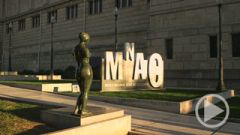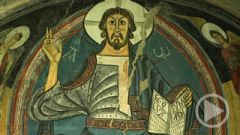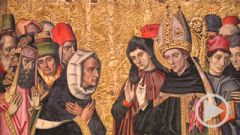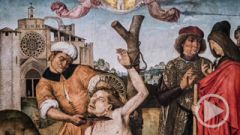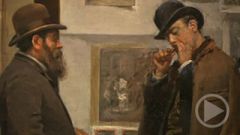Die Gotik
The Gothic Age
Barcelona, 23 December 1228: the Catalan Courts – or states-general – met and decided to take part in a military campaign with King James I of Aragon. Their target: the Balearic Islands that were still ruled by the Muslim governor Abu Yahya. And Pope Gregory IX has called for a crusade to reconquer them for Christendom. On 12 September 1229 the armies meet in battle at the mountain of Serra de Portopí – on the one side the Moors, on the other the Christian knights of Aragon, each bearing a coat of arms. The Christians won the encounter.
In the evening the knights rest; the king receives his associates in his tent. Among them is the Bishop of Barcelona wearing the miter instead of a helmet although he, too, is a warrior. Prayer and battle are no contradiction in the Middle Ages.
Now only the capital city continues to resist. The siege of Madîna Maûrqa, later called Palma de Mallorca, lasts three and a half months until the Muslim rulers surrender. Majorca is annexed to the crown of Aragon and the king becomes “James the Conqueror”.
These pictures are early Gothic masterpieces in the so-called linear style. Thick contour lines define the motifs and even the steep mountains that serve as a background and separate the individual scenes from one another.
The frescos were located in Barcelona’s Aguilar Palace and discovered during restoration work when the building was turned into a Picasso Museum. The find was a sensation, but the theme was no surprise; the house was built half a century after the conquest by the merchant Bernat de Caldes. His daughter was the mistress of King Alfonso the Candid, the grandson of James the Conquerer.
In the course of the 13th century the Crown of Aragon grew in importance. The Balearic Islands now belonged to it. In 1237 James had also conquered Valencia, later this was to be followed by the kingdoms of Sardinia and Sicily, and even briefly by the Duchy of Athens. It was a mighty empire, but although ruled by a single king, it was a confederacy of autonomous realms.

Catalonia flourished in the late Middle Ages. Catalan navigators and merchants dominated the western Mediterranean. Barcelona and Valencia vied with Genoa and Venice. In art and architecture, it was the start of the Gothic Period. The many altar paintings in the Museu Nacional show the gradual transformation in art over the centuries. Next to the architecture of the great cathedrals, the genre that is most closely identified with Gothic art is the altarpiece.
In Romanesque churches there was often a baldachin over the altar. This painting, for example, comes from in the church in Tavérnoles. Only the priest could see it during the service. In the Gothic period the images moved to panels behind the altar so the congregation could see them, too. It was the birth of the high altar retable. Additionally, the columns of Gothic cathedrals became slimmer and slimmer while the windows grew larger. That meant there was hardly any space on the walls for frescos. Instead, artists painted on wooden panels.
The heyday of Byzantine art was slowly coming to an end. Constantinople was finally conquered – first by Venice then by the Ottomans. In western Europe a novel artistic style developed. Italy was the main source of the new ideas, and these inspired painters in Catalonia – in particular Ferrer Bassa. While working in Italy, he had encountered entirely new images – above all, those of Giotto – and he brought the Italian master’s style to Barcelona.
The new pictures overcame the severity of the Byzantine icons. The figures were no longer stylized, but animated and three-dimensional. There is still the abstract gold background symbolizing the world of God. But more and more the people in the images are placed in concrete settings painted in perspective.
Ferrer Bassa and his son Arnau were among the most important painters in Barcelona until they both died of the plague in 1348. The fact that we know their names is a sign of the changing mentality; for the first time the artists emerge from their works. Earlier, painters and sculptors had viewed themselves as craftsmen who made their works in praise of God. Their own personalities were unimportant. But now the times were changing. The unlimited power of the church was waning. People turned to more earthly things. They grew more self-confident - and for the first time we know the names of the artists.

Among the most influential painters in Catalonia were the Serra brothers. Their workshop dominated the market in Barcelona between 1350 and 1400. It was the source of one of the museum’s most famous works, Our Lady of the Angels.
The head of the dead Savior. The fracture at the neck shows that it once belonged to the figure of a recumbent Christ. It was probably part of a scene at the Holy Sepulcher, a popular genre throughout the Middle Ages.
The artist is Jaume Cascalls, who made it in 1352 for the Augustinian monastery of Sant Agustí Vell in Barcelona. Cascalls was a major Catalan sculptor of the mid-14th century. This sculpture of St. Anthony is also attributed to him. It once stood in the Sant Antoni church in La Figuera in southern Catalonia.
The saint may have been modeled after King Peter the Ceremonious, at whose court Cascalls was employed as royal sculptor. The statue’s colors are well-preserved. Not only were all the sculptures in the Middle Ages colorfully painted, so was much of the architecture. It’s hard to believe today, but the (soaring) cathedrals of the Gothic period were also painted. This simple stone retable gives us an impression.
International Gothic
Towards the end of the 14th century a certain uniform artistic style spread throughout Western Europe. The people of Europe had a common culture: they were part of the same church; monks, pilgrims, merchants crossed the continent; so did architects and artists. The canons of the cathedral of Barcelona sent their chief sculptor Pere Sanglada to France and Flanders to buy oak wood for new choir stalls. Sanglada brought back not only the wood, but also modern artistic ideas.
These ornaments appear when the seats are folded up. The brackets on the underside are called Misericordia – or mercies – because the grateful canons could lean on them in the long periods of standing during the services. Most of the time the misericordia were hidden from view, which may be the reason why Sanglada decorated them with some very worldly scenes. Two men are vying to show who is stronger; two others are carrying the seat. Their faces are realistic; the folds of the clothing are three-dimensional, with soft, flowing lines.

This style is generally known as International Gothic. Originating in Bohemia, Burgundy and France around 1390, it dominated art throughout Western Europe for the next two generations. In Catalonia many artists were pupils of the cathedral sculptor Pere Sanglada. Among them was Pere Oller who himself became one of the major sculptors of the 15th century.
Alongside Barcelona, Valencia was one of the most important port cities of the Middle Ages, as well as an artistic center. Artists from a host of countries gathered here, bringing their local stylistic preferences. The northern Europeans specialized in realistic, vivid scenes while the Italians valued color. Gonçal Peris Sarrià’s work combined both. One of his masterpieces tells the story of St. Barbara in brilliant colors and horrifyingly realistic detail.
According to legend, a pagan king named Dioscorus had a beautiful and intelligent daughter who refused to marry. Instead she secretly became a Christian and dedicated her life to God. When her father found out he built a tower to imprison her. Barbara, however, was unfazed and merely begged the builder to install three windows instead of the intended two to symbolize the Holy Trinity. That has made her the patron saint of architects to this day. After a time she managed to flee, but was caught by her father. A shepherd had betrayed her – and God turned him and his flock to stone. Barbara’s father had her tortured to make her renounce her faith – in vain. Finally he murdered her. Barbara went straight to heaven – but her murderer met divine retribution.
St. Barbara is also thought to provide protection against thunderstorms – which is why she is especially popular in the countryside. This altar painting comes from a rural church in the village of Puertomingalvo at the border of the kingdoms of Aragon and Valencia.
Angels are at work repairing the roof of the stall. In the background another angel announces the birth of Christ to the shepherd and their flock. This love of detail is again typical of the International Gothic style.
The Christmas painting was not particularly lucky for its creators. Pere Serra had originally been commissioned with the work, but died before he could start it. Guerau Gener began the work in his place but also died soon after. It was completed by Lluís Borrassà, one of the most prolific artists of the Catalan Gothic period. He, too, had initially worked in Valencia and then moved to Barcelona.
The Hispano-Flemish School
After half a century the popularity of the International Gothic style began to decline. The power structures were changing. Cities began to challenge the hegemony of church and kings. While castles and villages still used the barter system, in urban areas money gradually established itself. Leading citizens accumulated wealth and power. As a merchant class they were realists –and that was reflected in the art of the time.
In 1443 the city councilors of Barcelona commissioned an altar painting for the city hall chapel. Lluís Dalmau spent two years completing it - in an entirely new style. He had learned it in Flanders. The court of Burgundy under Duke Philip the Good was a leading European center of the arts. Robert Campin, Rogier van der Weyden and Jan van Eyck all worked for it – and completely changed painting. Van Eyck in particular was the great pioneer of a new technique: working with oil paints instead of tempera he imbued his uniquely realistic paintings with light and atmosphere.

Lluís Dalmau enthusiastically absorbed the Burgundy style and began to paint three-dimensional spaces. The view out of his windows is of real landscapes. Dalmau portrays the councilmen with great realism; he makes them larger than the Virgin Mary. Just decades earlier that true-to-life detail would have been seen as blasphemy. The new painting style was popular and a close exchange developed between Catalonia and Burgundy. Many of the works from Barcelona are so similar to Flemish paintings that art historians speak of a “Hispano-Flemish school”.
Among its great masters – alongside Dalmau – was Jaume Huguet. He created the largest Gothic altarpiece in Catalonia for the Sant Agusti Vell convent. Eight of the panels have survived – five of which are on display here in the National Museum.
It seems likely that Huguet painted the consecration of St. Augustine and the Last Supper. The other pictures were designed by him and finished by other members of his workshop. The differences are plain to see in the faces: although the heretics disputing with Augustine are not badly painted, they cannot compare with the faces of the clerics in the Consecration picture. And the emotional faces of the apostles at the Last Supper also reveal the hand of the master.
Bartholomé Bermejo was another artist who took up the style from Burgundy. He, too, began to use oil paints in a realistic manner. Nothing is stylized in this work. Christ is receiving the godly on Judgment Day. He has broken open the gates of Hell, thereby crushing one demon. Other demons are tormenting a sinner – a highly realistically painted warning to the viewer not to stray from the path of virtue. In the background is the wide-open countryside.
The landscape plays a decisive role in the picture of the resurrection. The three Marys have come with flacons of perfume to anoint Jesus’s body. Behind them is the rising sun; it's as if the hand of the savior is pointing to it in benediction to say that with his resurrection a new day and a new age is dawning. And with the symbol borrowed from nature, a new age was dawning in art – the Renaissance.


